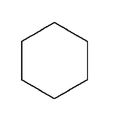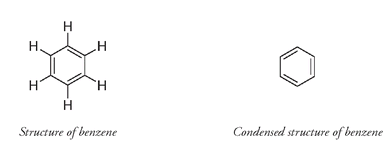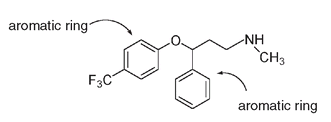Penny le Couteur & Jay Burreson (4 page)
Read Penny le Couteur & Jay Burreson Online
Authors: Napoleon's Buttons: How 17 Molecules Changed History
Tags: #Philosophy & Social Aspects, #Science, #General, #World, #Chemistry, #Popular Works, #History

It is particularly useful to leave out many of the carbon and hydrogen atoms when dealing with what are called cyclic compoundsâa fairly common structure in which the carbon atoms form a ring. The following structure represents the molecule cyclohexane, C
6
H
12
:
6
H
12
:

Abbreviated or condensed version of the chemical structure of cyclohexane. Every intersection represents a carbon atom; hydrogen atoms are not shown.
If drawn out in full, cyclohexane would appear as:

The fully drawn-out chemical structure of cyclohexane showing all atoms and all bonds
As you can see, when we put in all the bonds and write in all the atoms, the resulting diagram can be confusing. When you get to more complicated structures such as the antidepressant drug Prozac, the fully drawn-out version (below) makes it really hard to see the structure.

Fully drawn-out structure of Prozac
But the simplified version is much clearer:

Prozac
Another term frequently used to describe aspects of a chemical structure is
aromatic.
The dictionary says that
aromatic
means “having a fragrant, spicy, pungent, or heady smell, implying a pleasant odor.”
aromatic.
The dictionary says that
aromatic
means “having a fragrant, spicy, pungent, or heady smell, implying a pleasant odor.”
Chemically speaking, an aromatic compound often does have a smell, although not necessarily a pleasant one. The word
aromatic,
when applied to a chemical, means that the compound contains the ring structure of benzene (shown below), which is most commonly drawn as a condensed structure.
aromatic,
when applied to a chemical, means that the compound contains the ring structure of benzene (shown below), which is most commonly drawn as a condensed structure.

Looking at the drawing of Prozac, you can see that it contains two of these aromatic rings. Prozac is therefore defined as an aromatic compound.

The two aromatic rings in Prozac
This is only a short introduction to organic chemical structures, but it is actually all that you need to understand what we describe in this book. We will compare structures to show how they differ and how they are the same, and we will show how extremely small changes to a molecule sometimes produce profound effects. Following the connections among the particular shapes and related properties of various molecules reveals the influence of chemical structures on the development of civilization.
1. PEPPERS, NUTMEG, AND CLOVES
C
HRISTOS E ESPICIARIAS!
âfor Christ and spicesâwas the jubilant cry from Vasco da Gama's sailors as, in May 1498, they approached India and the goal of gaining untold wealth from spices that for centuries had been the monopoly of the merchants of Venice. In medieval Europe one spice, pepper, was so valuable that a pound of this dried berry was enough to buy the freedom of a feudal laborer bound to the estate of a nobleman. Although pepper now appears on dinner tables all over the world, the demand for it and for the fragrant molecules of cinnamon, cloves, nutmeg, and ginger fueled a global search that ushered in the Age of Discovery.
A BRIEF HISTORY OF PEPPERHRISTOS E ESPICIARIAS!
âfor Christ and spicesâwas the jubilant cry from Vasco da Gama's sailors as, in May 1498, they approached India and the goal of gaining untold wealth from spices that for centuries had been the monopoly of the merchants of Venice. In medieval Europe one spice, pepper, was so valuable that a pound of this dried berry was enough to buy the freedom of a feudal laborer bound to the estate of a nobleman. Although pepper now appears on dinner tables all over the world, the demand for it and for the fragrant molecules of cinnamon, cloves, nutmeg, and ginger fueled a global search that ushered in the Age of Discovery.
Pepper, from the tropical vine
Piper nigrum,
originating in India, is still the most commonly used of all spices. Today its major producers are the equatorial regions of India, Brazil, Indonesia, and Malaysia. The vine is a strong, woody climber that can grow up to twenty feet or more. The plants begin to bear a red globular fruit within two to five years and under the right conditions continue to produce for forty years. One vine can produce ten kilograms of the spice each season.
Piper nigrum,
originating in India, is still the most commonly used of all spices. Today its major producers are the equatorial regions of India, Brazil, Indonesia, and Malaysia. The vine is a strong, woody climber that can grow up to twenty feet or more. The plants begin to bear a red globular fruit within two to five years and under the right conditions continue to produce for forty years. One vine can produce ten kilograms of the spice each season.
About three-quarters of all pepper is sold as black pepper, produced by a fungal fermentation of unripe pepper berries. White pepper, obtained from the dried ripe fruit after removal of the berry skin and pulp, makes up most of the remainder. A very small percentage of pepper is sold as green pepper; the green berries, harvested just as they are beginning to ripen, are pickled in brine. Other colors of peppercorn, such as are sometimes found in specialty stores, are artificially dyed or are really other types of berries.
It is assumed that Arab traders introduced pepper to Europe, initially by the ancient spice routes that led through Damascus and across the Red Sea. Pepper was known in Greece by the fifth century B.C. At that time its use was medicinal rather than culinary, frequently as an antidote to poison. The Romans, however, made extensive use of pepper and other spices in their food.
By the first century A.D., over half the imports to the Mediterranean from Asia and the east coast of Africa were spices, with pepper from India accounting for much of this. Spices were used in food for two reasons: as a preservative and as a flavor enhancer. The city of Rome was large, transportation was slow, refrigeration was not yet invented, and the problem of obtaining fresh food and keeping it fresh must have been enormous. Consumers had only their noses to help them detect food that was off; “best before” labels were centuries in the future. Pepper and other spices disguised the taste of rotten or rancid fare and probably helped slow further decay. The taste of dried, smoked, and salted food could also be made more palatable by a heavy use of these seasonings.
By medieval times much European trade with the East was conducted through Baghdad (in modern Iraq) and then to Constantinople (now Istanbul) via the southern shores of the Black Sea. From Constantinople spices were shipped to the port city of Venice, which had almost complete dominance of the trade for the last four centuries of the Middle Ages.
From the sixth century A.D., Venice had grown substantially by marketing the salt produced from its lagoons. It had prospered over the centuries as a result of canny political decisions that let the city maintain its independence while trading with all nations. Almost two hundred years of holy Crusades, starting in the late eleventh century, allowed the merchants of Venice to consolidate their position as the world's spice kings. Supplying transport, warships, arms, and money to Crusaders from western Europe was a profitable investment that directly benefited the Republic of Venice. The Crusaders, returning from the warm countries of the Middle East to their cooler northern homelands, wanted to take with them the exotic spices they had come to appreciate on their journeys. Pepper may have initially been a novelty item, a luxury few could afford, but its ability to disguise rancidity, give character to tasteless dried food, and seemingly reduce the salty taste of salted food very soon made it indispensable. The merchants of Venice had gained a vast new market, and traders from all over Europe came to buy spices, especially pepper.
By the fifteenth century the Venetian monopoly of the spice trade was so complete and the profit margins so great that other nations started to look seriously at the possibility of finding competing routes to Indiaâin particular a sea route around Africa. Prince Henry the Navigator, son of King John I of Portugal, commissioned a comprehensive shipbuilding program that produced a fleet of sturdy merchant ships able to withstand the extreme weather conditions found in the open ocean. The Age of Discovery was about to begin, driven in large part by a demand for peppercorns.
During the mid-fifteenth century Portuguese explorers ventured as far south as Cape Verde, on the northwestern coast of Africa. By 1483 the Portuguese navigator Diago Cão had explored farther south to the mouth of the Congo River. Only four years later, another Portuguese seaman, Bartholomeu Dias, rounded the Cape of Good Hope, establishing a feasible route for his fellow countryman, Vasco da Gama, to reach India in 1498.
The Indian rulers in Calicut, a principality on India's southwest coast, wanted gold in return for their peppercorns, which was not what the Portuguese had in mind if they were to take over world dominance in pepper. So five years later, da Gama, returning with guns and soldiers, defeated Calicut and brought the pepper trade under Portuguese control. This was the start of a Portuguese empire that eventually extended eastward from Africa through India and Indonesia and westward to Brazil.
Spain had also set its sights on the spice trade, pepper in particular. In 1492 Christopher Columbus, a Genoese navigator convinced that an alternative, and possibly shorter, route to the eastern edge of India could be found by sailing westward, persuaded King Ferdinand V and Queen Isabella of Spain to finance a voyage of discovery. Columbus was right in some but not in all of his convictions. You can get to India by going westward from Europe, but it is not a shorter route. The then unknown continents of North and South America as well as the vast Pacific Ocean are considerable obstacles.
Other books
Pretty Toxic - A New Adult Romance (Imperfectly Yours) by Gardner, A.
Luana by Alan Dean Foster
Rasputin by Frances Welch
The Assassin by Evelyn Anthony
Reaper by Katrina Monroe
The Harrowing of Gwynedd by Katherine Kurtz
Plunder of Gor by Norman, John;
Tarnished Honor by J. Lee Coulter
Mollie Cinnamon Is Not a Cupcake by Sarah Webb